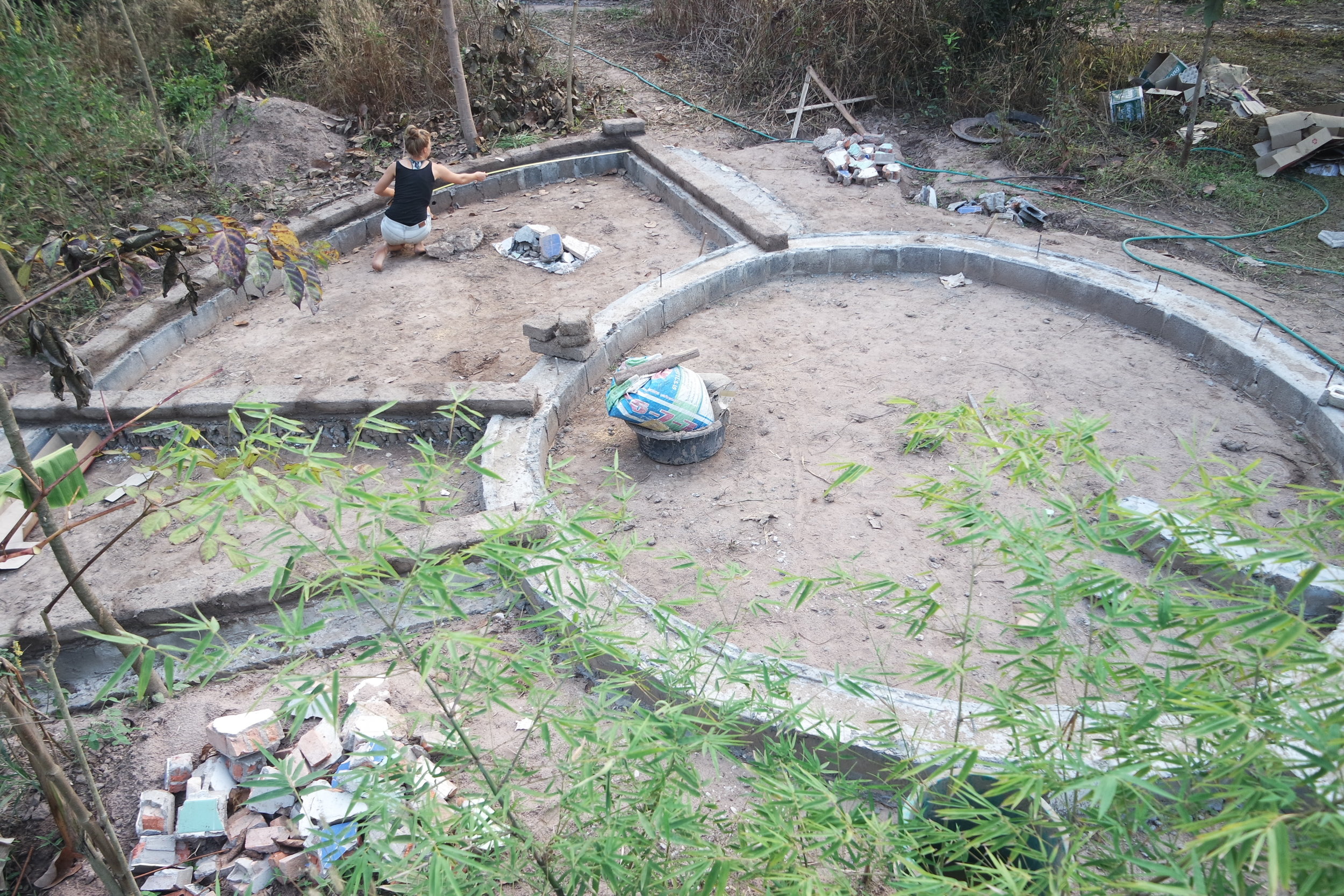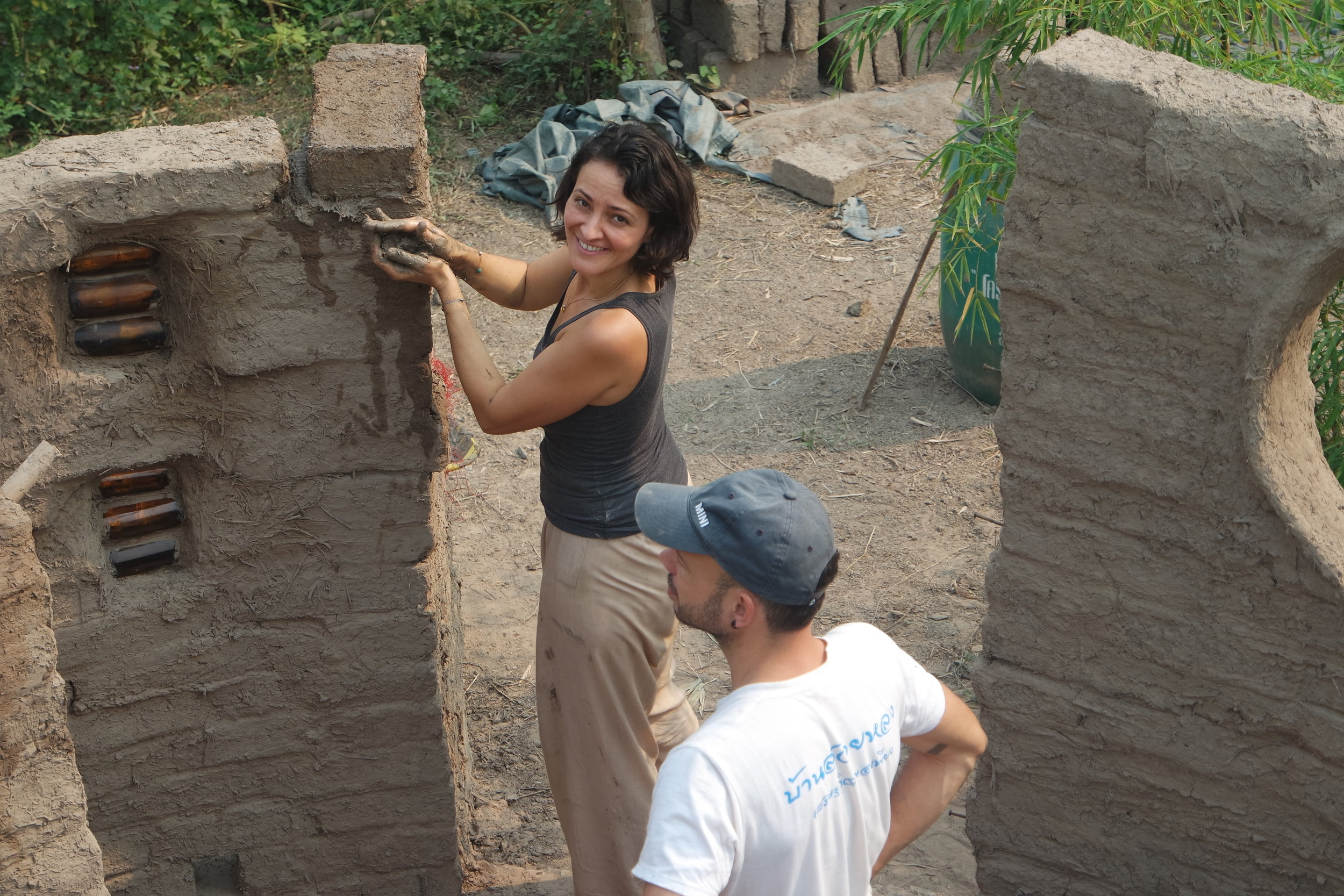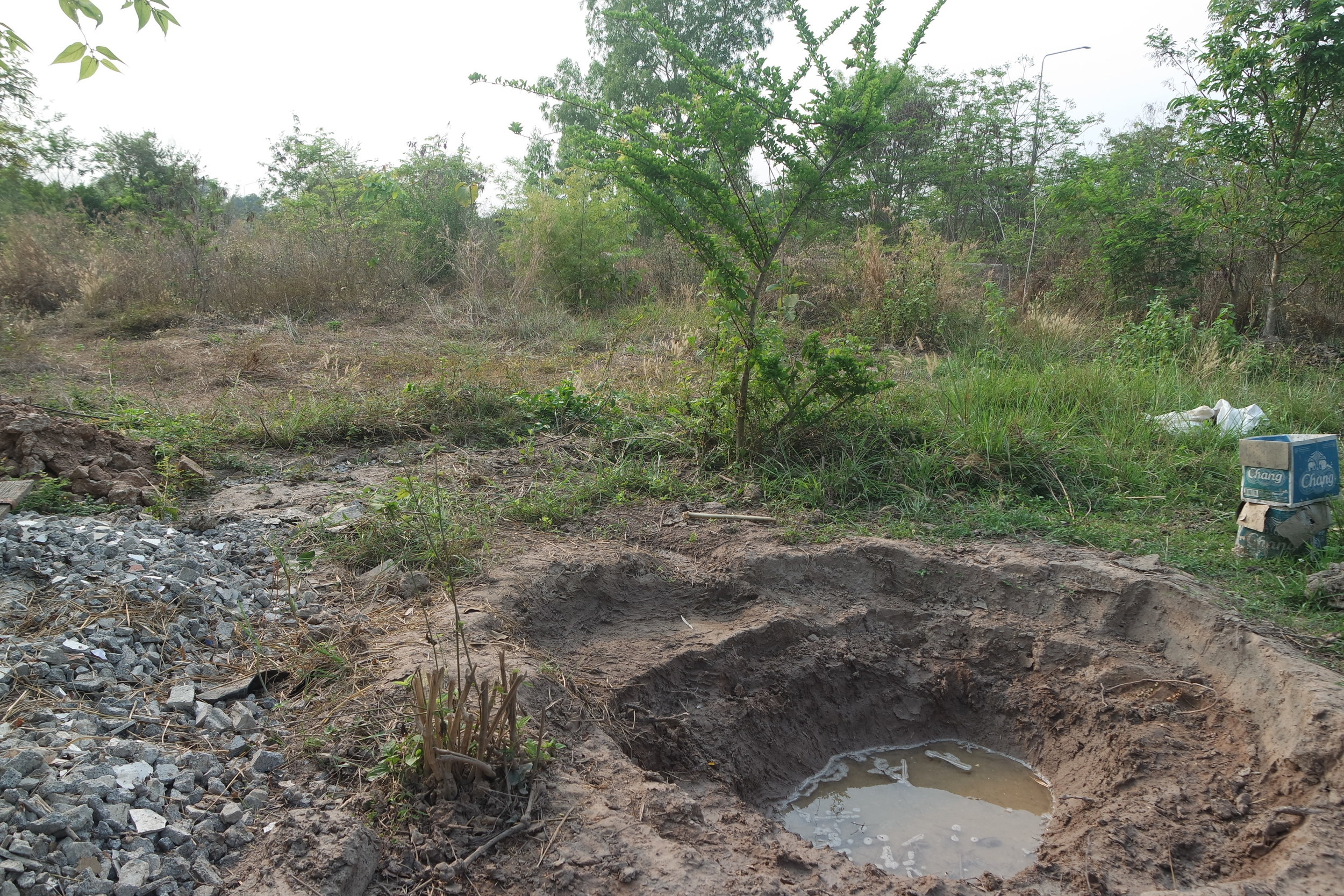It’s going up! Building mud bricks walls
Building a natural roundhouse:
Mud brick work for a natural structure
2 month after our arrival at the intentional community Gaia Ashram in rural area in the northeast of Thailand, we were able to jump in the mud pit and create the structure of our future shelter with a combination of mud bricks, love, loads of energy and the joint effort of the community. It's almost a week now that we laid the last brick and with that finished the walls after less than 4 weeks work. Now it feels like it is the right moment to reflect on the second milestone we passed on the way to our eco-home.
Author: Lars Blume and Karla Franielczyk
Starting from scratch.
Joint effort makes building even more fun.
We started to work on the walls and the integrated furniture and got finished within less than 4 weeks! 4 weeks full of joy, pain and pride. All in all, 4 great weeks with a successful end: all walls are done! We’ve laid 22 to 24 layers of earthen bricks that got connected with mud. We uses around 1,500 to 2,000 mud bricks and thanks to the energy of so many people we have been able to make it happen. The walls of our very first earthen house are the second step in the building process we can successfully tick off. We are so grateful that the people of Gaia Ashram, the community we live in, are giving us the opportunity to design and build our own house (read the blog post about why we moved into a community).
After finishing the foundation work, our self-confidence to build a house grew a lot as natural material is so much easier to handle than concrete. It just makes such a big difference to know that in case you screwed up you can knock everything down without producing any waste.
That is what's possible in 1 week when everyone is motivated and happy.
Taking turns and supporting people laying bricks with material is an important part of the work.
What’s important when building the main structure?
Are the walls load-bearing or not? Or is the main structure the connection point between the foundation and the roof? In our roundhouse we are working with walls only. We decided to eliminate wooden or concrete pillars and build a solid load-bearing wall instead. This is possible as we are building a 1-storey house and using solid mud bricks as wall material. Moreover, the round shape of the building is supporting the structure from outside forces and with benches and supporting walls on the outside we are adding strength to potential forces from inside. But trusting fully on the walls as the load-bearing structure means you have to build straight and solid to ensure a long-lasting building. In addition, the roof will be linked with rebar steel to the foundation in order to cope with the strong winds during the monsoon season in Thailand.
The best place in the new house. The sitting window will be a perfect spot to enjoy the sunset.
Why did we choose to build with mud bricks?
Among all the natural building materials we decided to go for mud bricks. But why? To be honest, this wasn’t our first choice. Actually, we were so inspired by The Dome Lombok, an earthbag dome project in Lombok, Indonesia that we wanted to build a dome too. We visit and interviewed the project for our podcast flowful meets... the episode with the dome will be online in the second half of 2018. As we’re big fans of reusing things, we thought that we might be able to reuse the existing rice bags at Gaia Ashram for building and by doing so recycling and locking in waste in the building. However, we figured out that the used rice bags in many cases were already exposed to the sun way too long and not able to hold the weight of the soil anymore. We didn’t want to buy new ones as this would add further waste when knocking down the house one day. Luckily, Gaia Ashram asked local craftsmen to produce 6,000 mud bricks earlier this year, using clay and sand from the community’s property. While time was flying and we had to adjust our design and finish the foundation we got ourselves together and recalled that our main aim is to use existing and local available resources and that the mud bricks are definitely the best choice.
Most of the other natural building techniques require additional structural elements or implement wood or other material for structural purpose that might attract termites and reduce the life time of the house. But we told ourselves that we will try to use as many techniques as possible in the future steps of the building to learn and understand the benefits and disadvantages better.
Incorporated furniture is easy in natural building.
Without the support of the Gaia community it would have been less fun building, for sure.
Are there any difficulties in building with mud bricks?
For a first building project and having mud bricks at hand it is a beautiful and easy-to-build technique. We worked with more than 15 short-term volunteers throughout the last 4 weeks and every single one was able to work with mud bricks and build parts of the wall. Sure, guidance and checking was needed but the majority was developing their skills quickly and the quality increased a lot within the first days.
Obviously, the existing shape of the bricks is not always fitting when building a roundhouse but cob and a machete helped us to keep the round shape. And one more time we experienced that the best thing when working with mud: there is no waste. Whenever we had cuttings, we just soaked them in water in our mud pit and used it the next day as mortar.
One thing that was indeed challenging was to make sure to think of incorporated furniture like shelves, boards, hangers and bottle brick artwork. It seriously took one whole day to disuss and sketch everything we wanted to be part of the walls. And to be honest, many times we forgot about it while building and we had to rethink the initial idea.
Working late in the last week and enjoying the cooler hours of the day.
With the filled bottles we will catch sunlight during the day and reduce the needed electricity.
Where does all the building material come from?
Mostly from the land! Bricks and mortar are made of clay and sand from the property, the rice husk is from a nearby rice mill, as well as the rice straw. We used reclaimed wood to incorporate shelfs and other furniture in the wall. That’s it! To keep the ways short we created our own mud pit next to the building side (which will become our future pond, whoohoo) and just added some clay from the other side of the property. Compared to the foundation work where we mainly had to bring in material, reclaimed or new, for this section of the house we’ve been able to use only materials from the land.
Ready for the roof!
Lessons learned
Yes, everyone can be a build with mud bricks and a clear design in mind. Building the main structure is quick, fun and very empowering. One thing we would do different next time is to check the door height before leaving gaps in the walls or work directly with the door frames to get the size right. For now, the door gaps look a bit too massive and it feels that this is reducing the stability of the entire building. Well, we will fix it and make it look beautiful, for sure.
Next steps
After working for nearly every day in the last 4 weeks we definitely need a break. Not only are our bodies tred but we also need to step back and give our minds a break.. Good thing we’ll travel to Vietnam and Germany! During our absence we hope to see the roof evolving so we are able to continue after returning to Gaia Ashram in May. From there on we will start plastering and start working on the earthen floor. Exciting!
Want to experience natural building
If anyone of you is traveling in Thailand or Southeast Asia and wants to be part of the building project please get in touch with us or directly via Gaia Ashram. We hope to finish the inner part around end of January 2019 and will focus on plastering the outside afterwards. See you in the mudpit!
Gaia Ashram together with NextGenoa and flowful will organize a Permaculture Design Certificate (PDC) Course between March 30 and April 18 at Gaia Ashram Thailand. You can find more information here or just drop us a message; we’re happy to hear from you and of course it will cover the basics of natural building.
At the moment we are designing the courses for our summer break (May/June) in Germany. We will have several weekend courses and also a PDC-Course happening. To get more information just write us a message; we will keep you posted.
Furthermore you can join Gaia Ashram an community based education centre as a volunteer and learn more about gardening, spirituality and nature connection, For futher information check www.gaiaschoolasia.com.
See you in our beautiful mud pit and future pond!











